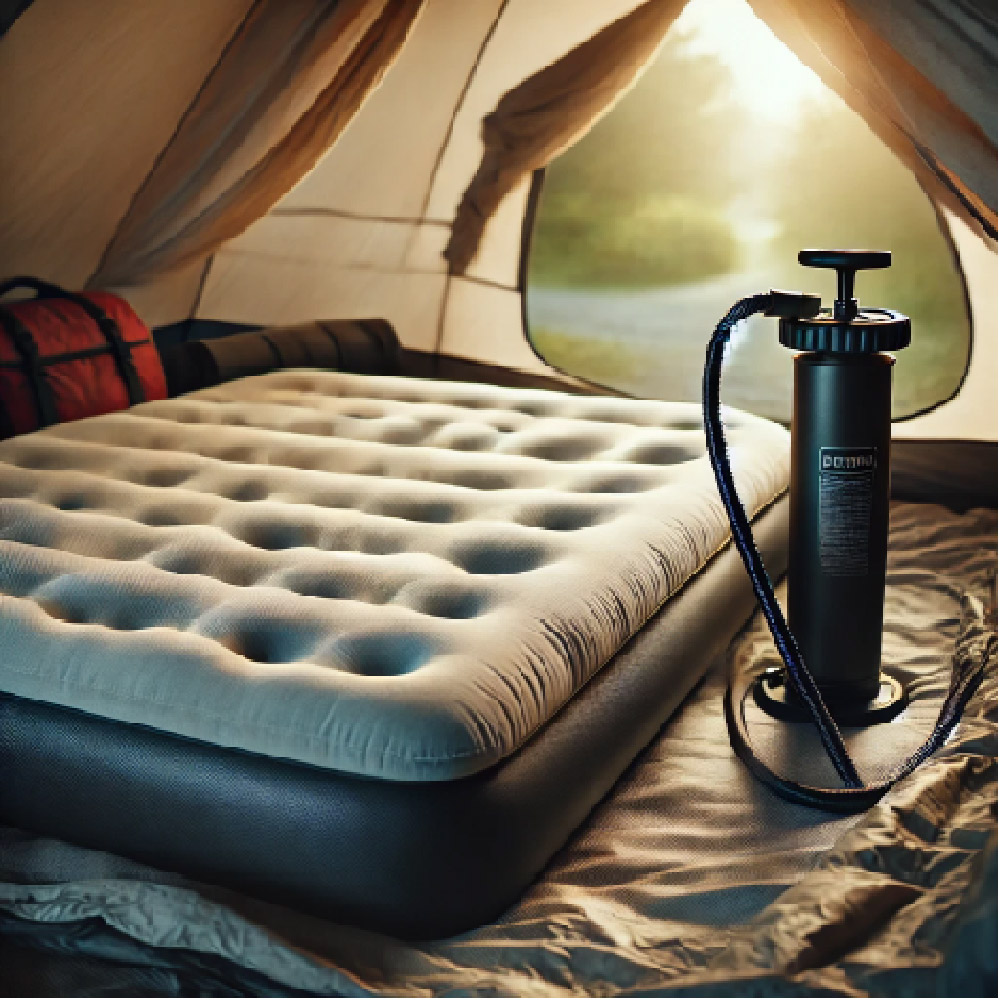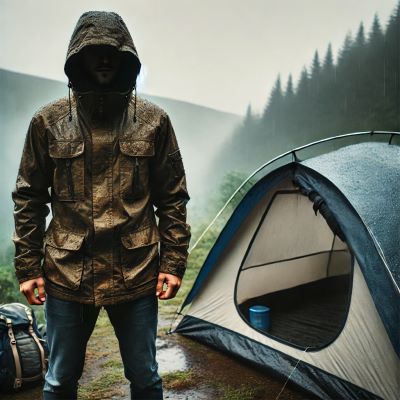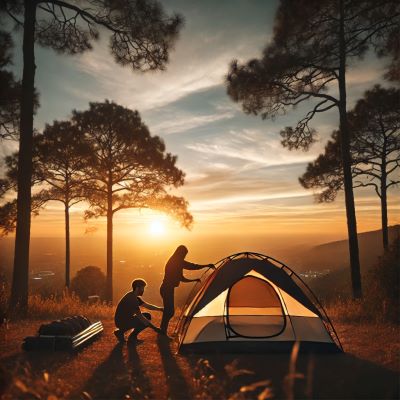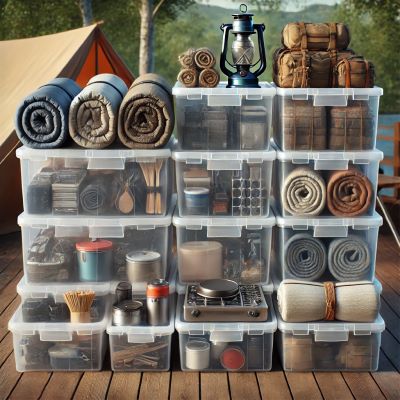
1. Choose the right tent.
Choosing the right tent is essential for a comfortable and enjoyable camping experience. When selecting a tent, consider the size, season rating, and setup requirements. For beginners, it’s often best to choose a tent that’s slightly larger than the number of people who will be sleeping in it to provide extra room for gear and movement. Look for a tent rated for the appropriate season: three-season tents are ideal for spring, summer, and fall, while four-season tents are built for harsher winter conditions. Additionally, pay attention to ease of setup—many beginner-friendly tents feature color-coded poles and intuitive designs to simplify the process. Investing in a high-quality tent with durable materials and a waterproof rating will protect you from unexpected weather, ensuring you stay dry and comfortable.

2. Practice setting up your tent at home.
Practicing setting up your tent at home is a smart way to prepare for a smooth camping experience. Setting it up in a familiar environment allows you to understand the tent’s structure, identify any tricky parts, and learn how long it takes to assemble, which will be invaluable once you’re out in nature. This practice run also gives you a chance to check that you have all the necessary parts, like stakes, poles, and rainfly, so you won’t be caught off guard when you reach the campsite. You’ll become more confident in the setup process, and if any issues arise, like hard-to-assemble sections or missing pieces, you can address them before your trip. Additionally, testing it at home lets you adjust the fit of ground tarps and understand how to secure the rainfly properly, making sure you’re prepared for any weather conditions.

3. Invest in a quality sleeping bag.
Investing in a quality sleeping bag can make a significant difference in your camping experience, especially for beginners. A well-made sleeping bag provides warmth, comfort, and protection from the elements, allowing you to sleep soundly and recharge for the next day’s activities. When choosing a sleeping bag, consider the temperature rating based on the lowest temperatures you expect during your camping trips. For versatile use, a three-season sleeping bag is often ideal, as it can keep you warm in spring, summer, and fall conditions. Quality sleeping bags use insulation materials like down or synthetic fills, each offering benefits; down is lightweight and highly insulating, while synthetic fill performs well in damp or wet conditions. Also, pay attention to the bag’s shape, as mummy bags provide more warmth due to their snug fit, while rectangular bags offer more room to move. Investing in a durable, high-performance sleeping bag ensures you’re comfortable and ready for any adventure nature brings.

4. Use a sleeping pad or air mattress.
Using a sleeping pad or air mattress is crucial for comfort and warmth while tent camping, as they provide insulation from the cold ground and add cushioning for a better night’s sleep. Sleeping pads are typically lightweight, easy to pack, and come in a range of thicknesses and materials to suit different preferences and camping conditions. Closed-cell foam pads are durable and lightweight, perfect for rugged or minimalist campers, while inflatable pads offer more cushioning and can be adjusted to your preferred firmness. Air mattresses, though bulkier, provide exceptional comfort and are ideal for car camping where weight isn’t a concern. Both sleeping pads and air mattresses help retain body heat, making them essential for cooler nights and preventing the chill from the ground from seeping into your sleeping bag. Choosing a quality sleeping pad or air mattress can make your camping experience much more enjoyable, allowing you to wake up refreshed and ready to explore.

5. Pack light but efficient.
Packing light but efficiently is key to an enjoyable camping experience, especially for beginners. Focus on bringing essentials that serve multiple purposes and avoid packing items “just in case,” as this can lead to unnecessary weight and clutter. Prioritize lightweight, compact gear designed for camping, such as collapsible cookware, quick-dry clothing, and travel-sized toiletries. When packing, think through your daily routines and select versatile items that will keep you comfortable and prepared. Organize your gear into categories—like sleeping, cooking, and personal items—and pack only what you’ll realistically need, considering factors like the length of your trip, expected weather, and activities planned. By keeping your load manageable, you’ll save energy, reduce setup time, and enjoy a streamlined camping experience that’s focused on the essentials.

6. Plan for weather changes.
Planning for weather changes is a vital part of preparing for a successful camping trip. Weather in the outdoors can be unpredictable, so it’s essential to check forecasts regularly in the days leading up to your trip and pack gear that prepares you for a range of conditions. Bring clothing you can layer, such as a moisture-wicking base layer, insulating mid-layer, and waterproof outer layer, to adjust your warmth and protection as the temperature fluctuates. A quality rain jacket, waterproof boots, and extra dry socks are particularly useful for unexpected rain or muddy conditions. Additionally, consider packing an all-weather tarp to provide shelter in rain or shade on hot days. Preparing for changing weather conditions not only keeps you comfortable but also ensures your safety, as staying dry and warm prevents risks like hypothermia and heat exhaustion. Thoughtful preparation allows you to enjoy your time outdoors, rain or shine.

7. Choose the right campsite.
Choosing the right campsite can make a significant impact on the quality of your camping experience. When selecting a spot, look for level ground free of rocks and roots to ensure a comfortable sleeping area and easy tent setup. Consider proximity to water sources like lakes or streams for convenience, but be sure to set up camp at least 200 feet away to minimize environmental impact and avoid potential flooding. Look for natural wind barriers, such as trees or bushes, which can help shield your tent from gusts and add privacy. Additionally, pick a location that offers shade for hotter days and is clear of potential hazards, like dead or overhanging tree branches that could fall. Finally, be mindful of campsite regulations or restrictions, as designated sites are often chosen for both safety and minimal environmental impact. Taking the time to select a well-suited campsite will help you stay comfortable, safe, and connected to nature throughout your trip.

8. Set up before dark.
Setting up camp before dark is crucial for a smooth, stress-free start to your camping experience. Arriving with enough daylight allows you to clearly see your surroundings, select the best site, and safely pitch your tent without rushing. In the light, you can identify potential hazards, like uneven ground, roots, or overhead branches, which are harder to spot at night. Early setup also gives you time to organize gear, set up your sleeping area, and prepare essentials, such as a campfire or cooking station, before visibility decreases. As night falls, it can be challenging to work with limited light, even with flashlights or headlamps, which can make simple tasks more complicated and potentially dangerous. By setting up camp before dark, you create a comfortable and safe environment, allowing you to relax, enjoy the evening, and settle into nature’s rhythm without stress.

9. Bring a camping chair.
Bringing a camping chair adds a touch of comfort and relaxation to your outdoor adventure, making it easier to unwind and enjoy your surroundings. Unlike sitting on the ground or using logs, a camping chair provides back support, a stable seat, and a clean, dry place to relax after a day of activities. Many camping chairs are designed to be lightweight, foldable, and easy to carry, fitting conveniently into your gear without taking up too much space. From enjoying a meal by the fire to watching the stars at night, a chair elevates the experience and helps keep dirt and insects at bay. Look for options with cup holders, side pockets, or built-in coolers for added convenience. Having a comfortable place to sit can turn your campsite into a cozy outdoor living space, adding to the enjoyment of your camping trip.

10. Stay organized with storage bins.
Staying organized with clear storage bins can make your camping trip smoother and more enjoyable by keeping all your gear easy to find and neatly stored. Clear bins allow you to see exactly what’s inside, saving time rummaging through items and reducing the risk of leaving anything important behind. Organize your bins by category—like kitchen supplies, clothing, and outdoor gear—so that you always know where to find essentials. Bins also help protect your gear from the elements, keeping items clean, dry, and safe from dust, dirt, and insects. Additionally, using labeled or color-coded bins can further streamline organization, making it simple for everyone to grab what they need quickly. When it’s time to pack up, having everything neatly stored in bins ensures an efficient and orderly process, helping you leave no trace behind and making your next trip even easier to prepare for.
Want to take your camping skills to the next level? Join our VIP Club to access our full ‘30 Tent Camping Tips for Beginners’ article, available exclusively in our Resource Guide! As a VIP member, you’ll get access to expert tips, insider guides, and special offers to make your outdoor adventures even better. Sign up today and start exploring!

Leave a Reply